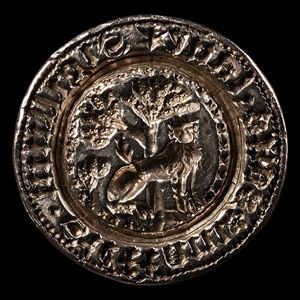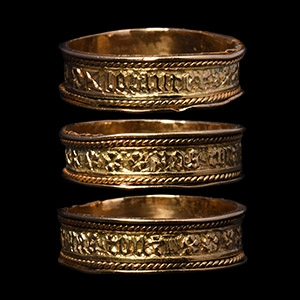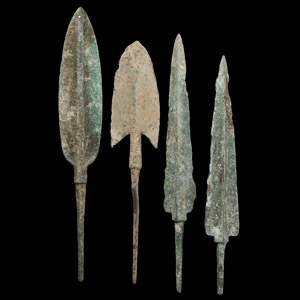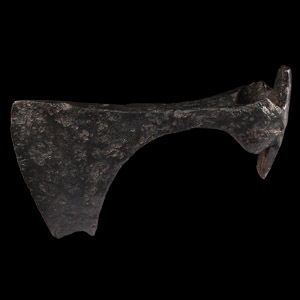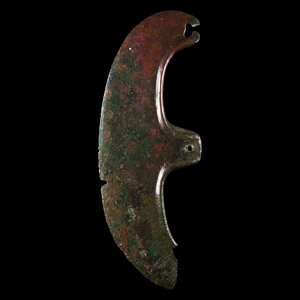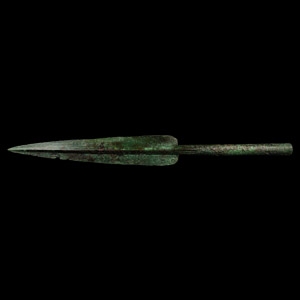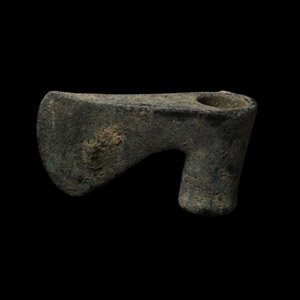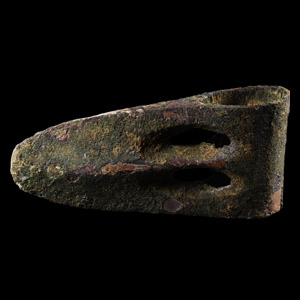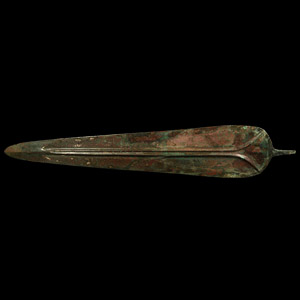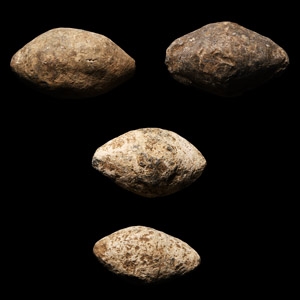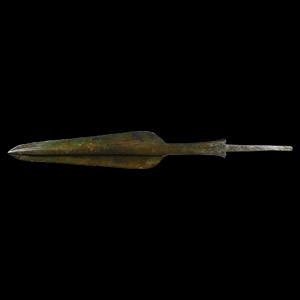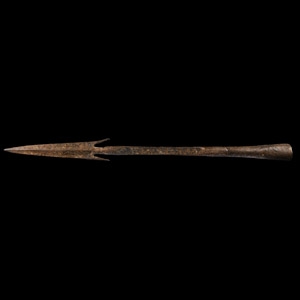Home > Auctions > 21 - 25 February 2023
Ancient Art, Antiquities, Natural History & Coins
Auction Highlights:
Acquired 1980-2015.
Ex Abelita family collection.
Acquired 1980-2015.
Ex Abelita family collection.
Cf. Muscarella, O.W., Bronze and Iron: Ancient Near Eastern Artifacts in The Metropolitan Museum of Art, New York, 1988, item 165, for type.
Many examples of these blades have been excavated in the South Caspian area at Ghalekuti, and in the area of Talish. They have been found primarily in Iron Age graves, although the curves of the guards are reminiscent of the barbed arrow and javelin heads associated with Bronze Age Marlik. This is why some scholars (Dyson) dated them to the second millennium BC and others (Muscarella) to the recent Iron Age. It is possible that this style represents continuity from the Bronze to the Iron Age.
Acquired 1971-1972.
From the collection of the vendor's father.
Property of a London, UK, collector.
Cf. Arbman, H., Birka I: Die Gräber, Uppsala, 1940, pl.14, item 3; Sedov, B.B., Finno-Ugri i Balti v Epokhi Srednevekovija, Moscow, 1987, table V, items 16, 17, 20.
Iron axeheads of this typology show a sub-trapezoidal asymmetrical blade, often perforated through the centre. They are characterised by two projections spurs from the top and the bottom of the back of the shaft-hole.
Acquired 1980-2015.
Ex Abelita family collection.
Ex important Japanese collection, 1970s-2010.
See similar typology in Khorasani, M.M., Arms and Armour from Iran - The Bronze Age to the End of the Qajar Period, Tübingen, 2006, p.626, cat.271.
The spearhead, cast in one piece, belongs to the type VIII, subtype B (triangular blade) of the Khorasani classification. Similar spearheads were excavated by Dr Negahban in the Marlik necropolis (tomb 1, trench III D) and are preserved in the National Museum of Iran, Teheran.
English collection formed in the 1990s.
UK art market.
Property of an Essex gentleman.
Unadorned weapons, especially axes, adzes and picks, were made by Luristan craftsmen using simple clay or stone bivalve moulds, into which was inserted a core to form the socket for the shaft. Typically, the metallic composition consisted of a combination of arsenical bronze and copper, together with a small percentage of lead.
Acquired early 1990s.
Ex private American collection; thence by descent.
Private Swiss collection since 1998.
Cf. Gernez, G., L’armament en métal au Proche et Moyen-Orient: des origines a 1750 av. J.C., Paris, 2007, fig.2.42, type H4b.
Acquired in the 1990s.
With a London, UK, gallery.
Property of a London collector; from her family's private collection.
See Khorasani, M.M., Arms and Armour from Iran. The Bronze Age to the End of the Qajar Period, Tübingen, 2006, s. cat 31, for type.
The metalworking techniques used in making bronze weapons in Luristan were very complex. Surfaces were often finished in repoussé work, and some of the weapons were chased, others engraved.
Found Roding, Essex, UK.
Acquired on the UK antiques market between 1974-1985.
Albert Ward collection, Essex, UK.
Similar shots were used in the civil war among Pompey and Caesar, and in all of Caesar's wars. The funditores of Caesa's age were part of the light infantry. Caesar speaks of his Balearic slingers during the conquest of Gaul. They wore a short tunic, with leather or rope sandals to the feet, and a warm overcoat which could also have been used to store projectiles. They also used a satchel to carry very deadly lead-like stones or bullets.
Acquired 1971-1972.
From the collection of the vendor's father.
Property of a London, UK, collector.
Accompanied by an academic report by military specialist Dr Raffaele D'Amato.
This lot has been checked against the Interpol Database of stolen works of art and is accompanied by search certificate no.114437-196034.
Cf. similar specimens in Zakharow, A., Arendt, W., Studia Levedica, Archaeologischer Beitrag zur Geschichte der Altungarn im IX JH., Budapest, 1935, fig.21, p.54, fig.22, p.56 (guards), pls. III,VI nos. 3,5; Lebedinsky, I., De l’epée scythe au sabre mongol, Paris, 2008, pp.172ff.; Gorelik, M., ‘The image of the men-warrior in Kabaria-Ugria-Russia (in Russian)’ in Archaeology of the Eurasian Steppes, no.5, Kazan, 2017, pp.257-267, fig.1, nos.1,5; Fodor, I., Revesz, L., Wolf, M., Nepper, I.M., Morigi Govi, C., Gli Antichi Ungari, nascita di una nazione, Bologna, 1998, p.132, no.117 (cat.515); Bashir, M., The Arts of the Muslim Knight, The Furusiyya Art Foundation Collection, Milano, 2008, p.34.
This exceptional sabre shows similarity with examples from the Caucasus and Kuban regions. The blade could be Khazar-Magyar, and certainly its best parallels are the specimens from Verchne-Szaltovo area. According to M. Gorelik, some of these sabres were produced by the Kabarians, a breakaway tribe from the Khazar State, who formed an alliance with the Magyars. The extra band welded beneath the quillons, together with the side tongue, not only protected the scabbard from being cut by the blade but, more importantly, defended the warrior’s fingers which were wrapped around the quillons when fighting.
Acquired 1980-2015.
Ex Abelita family collection.
See similar typology in Khorasani, M.M., Arms and Armour from Iran - The Bronze Age to the End of the Qajar Period, Tübingen, 2006, p.629, cat.278.
The weapon belongs to the type 1 of the spearhead classification by Khorasani, mainly from Marlik or Amlash areas. Similar pieces have been dated by Stutzinger to 1200-1100 B.C.
Acquired before 2000.
From the collection of a European gentleman living in the UK.
733 - 744 of 2116 LOTS


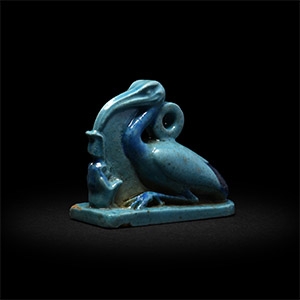



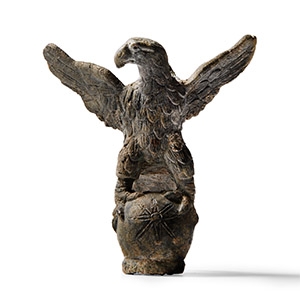
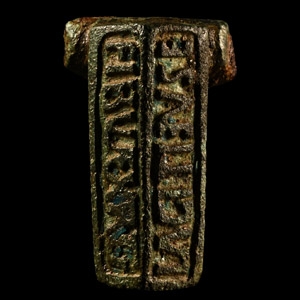

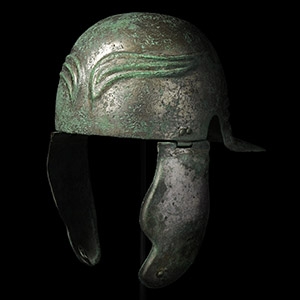
.jpg)
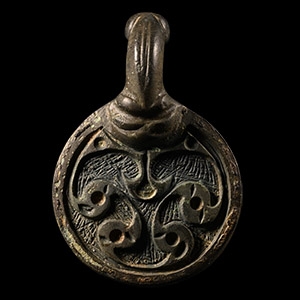
.jpg)
